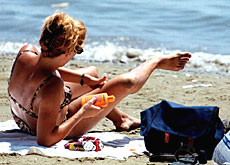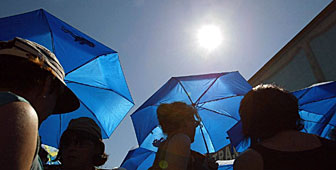Scientists raise health fears over sun cream

Swiss researchers are warning that some chemical ultraviolet (UV) filters in sunscreen could damage human reproduction.
They say certain substances are thought to act like female sexual hormones and that they could be absorbed into the body.
But despite the findings, both the scientists and the Swiss Cancer League are urging people to continue using sun cream to protect against the sun’s harmful rays.
The research, which was carried out by two teams at Zurich University, found that some chemical UV filters were biodegradable and soluble in fats – and therefore could accumulate in the body.
“Due to their chemical structure, they are suspected of behaving like natural sexual hormones and in this way of having a negative influence on human and animal reproduction,” said the Swiss National Science Foundation in a statement on Tuesday.
Margret Schlumpf, from the university’s Pharmacology and Toxicology Institute, discovered during a series of tests that eight out of ten UV filters acted like the female hormone, oestrogen.
Scientists tested the substances on rats and observed that the uterus in some sexually immature female rats matured earlier than in other rats.
They also found that female rats had fewer offspring and that they tended not to survive as long.
Results corroborated
The results have been corroborated by the Institute of Environmental Technology at Muttenz near Basel and by a British team.
“In male rats we observed that puberty was delayed,” said Schlumpf. “There was also a change in the weight of the testicles and prostrate gland, even with small doses of the products.”
“For both sexes, we also noticed changes in the activities of certain genes,” she added.
The scientists also developed a new test for assessing whether chemical UV filters could be absorbed by the skin. The results appeared to confirm that this was the case.
“We are talking about very complex problems – these products don’t have acute toxicity but insidious long-term effects on the environment,” wrote the Swiss National Science Foundation, which sponsored the research.
But the foundation added that it was still possible to enjoy the sunshine as long as exposure was limited and sun cream used – although it did recommend that children use cream containing mineral filters.
Cautious reception
The Swiss Cancer League, which is currently running a skin cancer prevention campaign, reacted cautiously to the news.
Ruth Barberzat, who is in charge of the campaign, said the organisation had taken the results on board but insisted it would not change its position on the use of sun cream.
“The link between the results of these tests on rats and the absorption of the filters through the skin has not strictly been proven,” she told swissinfo.
“As a consequence, our official position – like that of dermatologists – is that one should continue to protect oneself against UV, and therefore use sunscreen.”
“For people who are worried, we advise using creams with, for example, a mineral filter,” added Barberzat.
The Swiss Society of Chemical Industries has also questioned the results. It said the effects of such hormonal substances had been intensively researched by the industry but with different results.
Following a 2002 study, the World Health Organization (WHO) said such hormone or endocrine disruptors did not pose any serious problems to human health.
However, the WHO admitted that children were likely to be more sensitive than adults, and it has called for more research to be conducted.
Apart from sun cream, endocrine disruptors are also said to be found in perfume and cosmetics.
swissinfo with agencies
1,500 people get skin cancer each year in Switzerland – 20% die as a result.
The number of skin cancer victims has doubled over the past 15 years.
Skin cancer can be caused by overexposure to UV rays, but skin and hereditary factors are also thought to contribute.
The reduction of the ozone layer means that more UV rays reach the earth.

In compliance with the JTI standards
More: SWI swissinfo.ch certified by the Journalism Trust Initiative

You can find an overview of ongoing debates with our journalists here. Please join us!
If you want to start a conversation about a topic raised in this article or want to report factual errors, email us at english@swissinfo.ch.